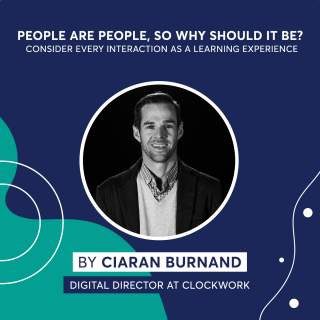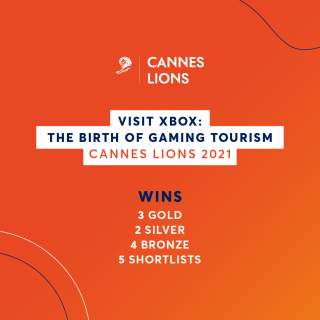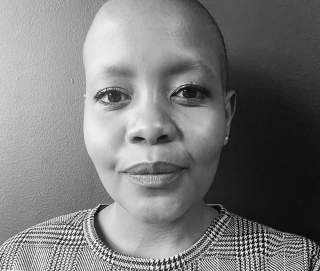People are people so why should it be?
So we're different colours and we're different creedsAnd different people have different needsIt's obvious you hate me though I've done nothing wrongI've never even met you, so what could I have done Lyrics written by the great Martin Gore of Depeche Mode and released in 1984 (No George Orwell reference just the year) but could just very well be lyrics from a song in 2021 about social media?So often online I see articles, tweets or people talking about how to succeed in this, or how to earn more money doing that.
So many people chasing the latest or the trendiest piece of digital flesh out there. Digital cult cannibals ready to consume the latest offering or blindly follow the next influencer in order to appear more knowledgeable and climb the ladder. The higher the ladders goes the more things change.
At Clockwork https://www.clockworkmedia.co.za and https://www.clockworkmedia.co.uk we run a mentoring programme, where the more experienced or senior people in the company, ‘pitch themselves’ to our large pool of stirring and cool up-and-comers. The premise is that they are then selected as a mentor to help guide people on their work journey.
During this process the one line of questions that seems to appear more often is this….”How do I build my career?” “When do I know to move on to the next level?” “What should I do to progress in my career?”I can only respond with what my personal experience and knowledge has been, which is that in order to succeed, you need to understand people.
For me the biggest challenges and achievements have all revolved around people. The biggest learnings I have came from interactions with people. Looking back on my experience now, the fact that I managed people, since I was about 19, has provided me with many grey hairs with a significant amount of different scenarios and situations.
All of these have helped me build my People IA: Intelligence Amplification or Intelligence Augmentation. This is in fact the opposite of AI: Artificial Intelligence. To quote from this Forbes article https://www.forbes.com/sites/quora/2017/03/02/the-opposite-of-artificial-intelligence-could-be-the-key-to-saving-tech-jobs/
“Our brains are more complex than any computer we know how to make, our brains are also far more creative.”So my guidance to help you succeed is to become a Generalist of People. Consider every single interaction as a learning experience. Allow this interaction to shape your approach.
Once you know what your approach to people is, stick to those doctrines, preach them to yourself and others. People won’t always listen to you the first time…or second time…or third time! It requires constant attention and commitment. In addition, listen to people, really listen. Through my 25 years of interactions I have slowly but surely found my guiding principles. They speak to me because they align to my own beliefs not just because I think they would sound cool.
Because of that it is natural for me to live and preach them…another key element to progress. A balance with your views is fundamental.
Also have the foresight to realise that your teams and your own views will need to adjust over time to consider such things as working from home. Kindness is one of my key values, along with having fun and giving a sh!t! None of this is groundbreaking or new but it links directly to people, not trends, not technology. Kindness provides the ability for people to be people. It provides a fertile environment to care about mental health. And above all else, kindness is free but is worth so much.
When teams (made of people) each put in an extra layer of kindness even just a small percentage each, the combined impact is exponential. This aids in developing a space where help is the norm and people consider their communication and interactions.
But what exactly is kindness? Don’t just take my word for it, the South African College of Applied Psychology have this to say: “Kindness means different things to different people and it can be expressed in many varying ways. Kindness is an intentional action and often causes a positive chain reaction. At its basic level, it is being friendly, considerate and generous. You can see it in action when someone is gentle, warm, affectionate, empathetic or concerned about someone else. To be kind isn’t a weakness.
Often it takes courage and strength to be kind. Especially when doing so continuously is difficult, unappreciated or unreciprocated.
”The full article can be access here https://www.sacap.edu.za/blog/applied-psychology/kindness/
But why do we need kindness?My wife shared an article with me last night that helped me close off and understand why. I believe that kindness helps with our Window of Tolerance. The Window of Tolerance, developed by Dan Siegel describes the best state of stimulation in which we are able to function and thrive in everyday life. When we exist in this window, we can learn effectively, play and relate well to ourselves and others.
Everybody’s Window of Tolerance is different, but by providing a kinder environment we allow more room for tolerance. Getting back to Depeche Mode, I finish with this:“I'm relying on your common decencySo far, it hasn't surfaced but I'm sure it exists”
Why we should #RewriteOurProverbs to change the GBV narrative in SA
Proverbs are a part of us as a collective society. They can be called axioms, sayings, and adages and are only really explicable by action. Generally, it’s an older saying without a known author that’s considered wise and true across certain societies. They’re important, timeless, and comforting in their general relatability, truth, and reflexiveness on society at large. Basically, they’re indicative of the values of a society and all it holds as true. Through the ages, proverbs have been used to indicate how women should conduct themselves and proverbs all over the world carry the tradition of misogyny as ingrained within its words passed down from generation to generation.
“For a woman, display is dishonour,” says a Swahili saying from Tanzania. But “Women are to be seen and not heard,” according to the 15th-Century collection of homilies written by an Augustinian clergyman, John Mirk. These seemingly contradictory statements are both ancient proverbs that dictate women’s preferred behaviour but even in their contradictory nature, it’s not so hard to see the overall intention - women should be controlled in a manner that suits the society in which they live.
The purpose of being seen and not heard is to look pretty and be viewed as an object and to not be on display at all is to be an object. These are just two examples of myriad proverbs that claim morality and not just the preferred conduct of women but that society knows better than women themselves about how they should practice womanhood. Many of these proverbs were written by men in power within political or religious institutions. Proverbs dealing with women can be summed up by this Bengali saying: “She who laughs often or walks with bold steps is a harlot.” The fact that these prescriptive words have survived through the ages is indicative of just how the sentiments of misogyny have endured with them and that not much has changed in terms of how society would like women to be seen … and not heard.
Organisations such as the Green Door Women’s Shelter believes that the parts of our culture that demean women need to be removed from tradition. Through its Rewrite our Proverbs. Write off GBV campaign, the Clockwork digital agency has partnered with Green Door to actively cancel, edit, and promote a whole new view of traditional women’s proverbs, effectively dismantling and disempowering antiquated phrases and proverbs on which we were all raised and steering the narrative towards equality and respect.
The campaign kicked off on the back of Women’s Month this year to highlight the number of toxic proverbs in South Africa in the hopes of generating awareness about the national epidemic of gender-based violence. Through billboards, influencers, and public relations drives, the campaign aimed at steering awareness towards showing the public how problematic some of our traditions have been and still are. According to Green Door, “When we change the way society views a woman’s value, we can begin to repair deeply-rooted mindsets that ultimately perpetuate the cycle of gender-based violence. A lot of work needs to go towards fixing the systemic belief systems that keep women at a disadvantage in the eyes of society, but through small changes being applied by establishments … we will ultimately find female empowerment becoming more recognised.”
The way in which we speak has a huge impact on how we shape our world and what we see as acceptable and what isn’t. When these prescriptions are not respected and wives and daughters break out of the moulds that religious and political leaders, husbands, and fathers have so carefully tried to harden into society, aggressive solutions soon follow - verbally, sexually, mentally, or otherwise. The gender-based violence that ensues is most often the solution to any problem that a man cannot handle. As the German saying goes, “Women and chops - the more you beat them the better they'll be”. The Chinese proverb advises, “Clubbing produces virtuous wives”. The English proverb, “Women, like gongs, should be beaten regularly” is still used in the US today and in Korea, “A woman who is beaten is going to be a better wife” is often repeated when a wife steps out of line.
To say that progress has been made since these proverbs were written is almost laughable because as recently as 2010, beating was still considered a legitimate form of punishment if a husband did not receive sexual satisfaction from his wife in Egypt. However, the religious leader who kept the rule instated said, “There is a beating etiquette” and that beatings must avoid the face because they should not make a wife ugly. They must be done at chest level. He recommended using a short rod.
That rod being the “rule of thumb” as set out by the 18th-Century judge, Sir Francis Buller, stating that a man may beat his wife with a stick no wider than his thumb. The idea that well-behaved girls and women do not talk, ask questions or give orders all point to the same root: sounds that exceed silence and soft whispering are disapproved of and all forms of baring skin or dressing in certain ways cause women to draw attention to themselves and all of them are, in a word, bad. Should women not adhere to subservience, they should - and indeed do - face the societal punishment of shame and violence at the hands of the men who police that behaviour. Our proverbs need to change in order for these ideas to change.
We must change the language we use for future generations to break free of the antiquated ideals we have of women - ideals that not only no longer hold up but were never even valid to begin with. Projects such as the Green Door Women’s Shelter’s are necessary and should be wider spread so that we don’t instil these frankly idiotic sentiments in our society where misogyny no longer has a place. Giving these sayings the boot, in a proverbial sense, may go a long way in eradicating sexism and gender-based violence, in a literal sense.
Clockwork’s Marketing Learnership Programme is now open to applicants
Young marketing learners can jump on the right path with free education and work experience by applying for Clockwork’s annual Marketing Learnership Programme, which is now open to applicants. In partnership with Red & Yellow Creative School of Business, Clockwork has five slots available each year, offering students and aspiring marketers the chance to learn from the best with a comprehensive 12-month programme.
The learnership programme consists of six months of classroom training and six months of integrated work learning at the Clockwork offices in Johannesburg. Students receive a holistic look at the world of marketing by studying Communications, Strategy, Content, Digital and Design in the course.
This is the perfect way to get a foot in the door of marketing or advertising, and the Clockwork Marketing Learnership Programme is open to anyone with a matric, regardless of previous marketing experience or education.
Applicants are encouraged to submit their CV with a cover letter and a 30-second video explaining why they should be the next learner at Clockwork. Apply here: https://www.clockworkmedia.co.za/careers/marketing-learnership-program/
Green Door Women’s Shelter rewrites African proverbs to shift the narrative on gender-based violence.
“We can’t change the past, but we can start a new story for all South African women.”– Brown Lekekela, founder of Green Door Traditionally, our cultural heritage has not groomed men to be a safe haven for women. Whether African, English or Afrikaans, problematic proverbs remain steadfast, normalising the fate of the burdensome life that often befalls women in South Africa. Green Door Women’s Shelter believes that the parts of our culture that demean women need to be removed from tradition.
Through the ‘Rewrite our Proverbs. Write off GBV’ campaign, Clockwork has partnered with Green Door to actively cancel, edit and promote a whole new view of traditional women’s proverbs, effectively disempowering antiquated toxic phrases and proverbs that we were all raised on, and steering the narrative towards equality and respect. The campaign kicked off on the back of Women’s Month to highlight the high number of toxic proverbs in South Africa with the hope of generating awareness about the national epidemic of gender-based violence.
Through an extensive billboard, influencer and public relations drive, steering awareness back towards conversation change will hopefully help see the public how problematic some of our traditions have been. When we change the way society views a woman’s value, we can begin to repair deeply-rooted mindsets that ultimately perpetuate the cycle of gender-based violence.
A lot of work needs to go towards fixing the systemic belief systems that keep women at a disadvantage in the eyes of society, but through small changes being applied by establishments, such as the Green Door charity, we will ultimately find female empowerment becoming more recognised.
Green Door is a registered non-profit organisation that offers temporary shelter, emotional support, and counsel to survivors of rape and gender-based violence, with a strong footing in the Diepsloot community. The company was started by Mr Brown Lekekela, who facilitates an environment that provides holistic support through his centre.
Survivors also reach out to Green Door for medical treatment, legal advice and personal empowerment through skills development programmes. Lekekela’s vision is to break the cycle of violence by empowering women with knowledge about their rights and the skills to lessen dependency on their abusers.
This also involves educating men and youth on gender justice. He firmly believes that “violence is a learned behaviour that can be changed”. Lekekela has been the recipient of significant recognition for his efforts, including the 2016 LEAD SA Hero Of The Month, the 2020 Mail & Guardian 200 Young South Africans and the 2020 Giraffe Hero of the Month awards.
Yet, despite the phenomenal contribution to the community, the shelter receives no governmental funding. It is through corporate and private funding that the shelter is able to maintain the high standard of aid provided to the community. Find ways to contribute to the Green Door initiative here: https://greendoorshelter.org and add your voice to ending the cycle of gender-based violence in South Africa.
-- ENDS --
Social media call to action & hashtags: #WriteOffGBV & support the Green Door Shelter #RewritingOurProverbs – write off GBV Instagram handle: @greendoorinitiativesa
Gaming as a new marketing platform
Gaming, including online gaming, as a hobby has seen incredible rapid growth over the last few years, with lockdown and COVID-19 just acting as accelerants. Shifting drastically from niche cliques into extensive mass markets, alongside gaming’s growth comes new opportunities for brands to align appropriately and turn the sector into a lucrative playing field for brands and organisations to explore.
Today, gaming is a billion dollar industry, setting the trend in motion for brands to spread awareness within popular games and platforms. Big brands have started to create interactive marketing tactics – and some have wielded great results in their efforts. However, the passion and power of gamers’ enthusiasm can either make or break brands who try and enter their world without having the right context. Let’s dive into what the gaming industry looks like as a whole. Before 2020, the gaming industry had already seen 9% year-on-year growth. Add lockdown to the equation and we see this as an industry that will grow by 30% by 2023. Looking at the African continent, South Africa is definitely one of the largest video game markets.
There are more than 11 million gamers in South Africa alone, and that number increases as access to certain platforms becomes easier. South Africa’s gaming majority is moving towards social gaming, the free-to-play revenue model with in-game purchases. In-game purchases enable players to only buy parts of the game they want, giving them the chance to sample and enjoy a game for free and to tailor their gameplay experience by purchasing extra content.
eSports gaming, also known as competitive gaming, is also booming in South Africa, with a revenue of R46 million in 2018. It is expected to soar to R138 million by 2023 due to far better internet connectivity, access and speeds. Worldwide, eSport gaming is hugely popular as competitive gamers join large, event-style competitions and go all out for large cash prizes.
The eSport space has become completely professionalised with sponsorships, and ambassadors and icons are becoming worldwide stars almost overnight based on their scoring and successes. It makes sense then that sources state the growth spurt of eSports has led to advertisers looking for ways to capitalise within this sector. Brands such as Coca-Cola and Mercedes-Benz moved eSports from their experimental marketing budgets to core sponsorships, resulting in an estimated 34% growth boost in eSports gaming during 2019 alone.
So, who are brands and marketers targeting in the gaming industry today?
As per a study by Global Web Index, there’s a new demographic that has taken significant interest in gaming. This unexpected audience happens to be the older generation in the 55–64 age group; they mostly use mobile apps to play solo games or play games with their children and grandchildren during lockdown. We see an impressive 32% rise in this market.
Female gamer numbers have also shot up by 14%, where previously, non-gaming females spent more time gaming with partners, subsequently resulting in getting hooked on the hobby. Other consumer insights show that the motivators for what drive people’s interests in gaming are excitement and challenge seeking, as well as gaining strategic skills. There are new gaming enthusiasts that entered the gaming market since the pandemic for a ‘wonderful escape’. Gaming audiences are also viewing their gaming time as a good way to socialise online with new people when isolated in lockdown conditions and beyond.
What platforms are the best for brands to market on?
The top three gaming platforms are PC, console and mobile gaming. PC games provide a reliable gaming foundation; however, growth is slow compared to other platforms. Although there are a wide variety of games available to play on PC formats, gaming PCs are quite pricey and require a very stable internet connection for the best user experience. PC gaming is possibly not the best platform for brands to market on based on the slower growth of the platform. In other words, mobile and console gaming are impeding the growth of the PC gaming market.
Console gaming has seen an incredible increase in recognition, especially since the upsurge in technical sophistication, and now forms a relevant part of the home entertainment ecosystem. It’s the fastest growing gaming platform; however, advertising for console games is more difficult than for PC or mobile games as digital advertising cannot reach the console directly. Mobile gaming is seeing immense growth because of the ease of access to cellphones and because it currently has the largest market share. The mobile platform is the easiest way for marketers to get involved, with at least 69% of the global population choosing this platform for their gaming. With advertisers seeing spectacular gaming growth, they are sitting up and taking notice of this medium as a platform to create significant brand awareness. However, many games on mobile devices are very poor in quality and are not popular amongst eSports players or aficionados.
Examples of marketing excellence in the gaming sector Pokémon Go
Pokémon Go partnered with The North Face and Gucci, giving players the chance to deck their virtual selves out in designer clothes. The game also had instructions on how players can get the real merchandise to match their in-game personas.
Louis Vuitton
Louis Vuitton designed the case for the League of Legends World Championships trophy and introduced fashionable skins in gaming, which could be purchased by players for their in-game avatars.
KFC Philippines
KFC Philippines built its own island on Animal Crossing, complete with a restaurant, and invited players to search the island for Colonel Sanders. Those who found him were able to win free real-world food.
Fortnite
In April 2020, hip-hop megastar Travis Scott collaborated with Fortnite to offer players an in-game concert played at pre-advertised time slots. Users could find concert posters on walls within the game or social media. Once logged in to the game, users were treated to a stunning visual experience that featured Travis's giant hologram.
Times have changed from when gaming was stereotyped as a playground for geeks and high school dropouts. The audience has expanded so widely that advertisers have seen the potential for more than just niche audience responses. Gaming is serious business. This common pastime should no longer be taken lightly. Where passion exists, authentic opportunities will arise for the right brands.
Clockwork brings home 9 Cannes Lions for Xbox with McCann collab campaign
Clockwork once again delivers for the Xbox account by scooping a total of 9 Cannes Lion Awards, with a further 5 shortlists for their VISIT XBOX - THE BIRTH OF GAMING TOURISM campaign.
In partnership with McCann UK, Clockwork was responsible for the digital production on the campaign that saw XBox showcasing whole new worlds – away from traditional gaming and into a world of global travel and tourism exploration.
In a ground-breaking partnership with travel experts Rough Guide, the games were built around actual worldwide destinations with full tours of locations, setting choices, comprehensive writing and research, information holiday packages and so much more. The concept of ‘gaming tourism’ allows the public to explore the world through the eyes of one of the most detailed and up-to-date travel information guides and ‘not to play, but to visit’. Reaching brand new audiences that didn’t want the heroes, guns and combat of gaming, the Visit Xbox - The Birth Of Gaming Tourism initiative opened up a brand new dimension to the gaming platform.
Digital Director of Clockwork is thrilled at the recognition for his team, “I am over the moon that the team gets rewarded for their mind-blowing talent and enthusiasm”, he stated.
Visit XBox – The Birth Of Gaming Tourism as a concept is testament to the platforms innovation and diversity, reaffirming why it’s one of the leading gaming consoles in the world.
CLOCKWORK welcomes Mathabo Diale as Client Service Director
Clockwork is thrilled to announce the appointment of Mathabo Diale in the position of Client Service Director. With the aim of providing dynamic strategic advice and management to all the Clockwork accounts, award-winning Diale is known in the industry for striving towards excellence, building strong relationships and offering invaluable support to her teams.
After six years as Business Unit Director of the Brave Group, she is looking forward to bringing her strong work ethic and expertise to the Clockwork group, “I’m very excited to join this team and I think the timing of the appointment couldn’t be more perfect. Having previously managed mostly ATL campaigns and clients, this will be a great learning opportunity for me personally.
I look forward to building great relationships with clients and creating exciting work with the agency”, Diale states. Clockwork Co-CEO Tom Manners adds, “Mathabo is a fantastic addition to the Clockwork team. Working with enthusiastic, energetic professionals is something our agency is known for and I believe her appointment will bring invaluable nurturing and development to our client roster both now and in the future.”
No more tough guys, just good fellas, please
Since around the 1920s, when the sales era of advertising was introduced, marketing has been building visual gender stereotypes to convince people to purchase products and leaning heavily on societal biases for genders as part of their product or brand story. This has been the bedrock of a singular perspective of masculinity best described as the ‘tough guy’.Although the world of marketing has always known it portrays a biased, generalised view, with times changing and society fighting for equality across the board, the conversation has been pushed out enough for the industry to realise just how detrimental gender stereotypes have been to not only individuals, but also to the brands we, as marketers, represent.So, while for generations exaggerated ideas of masculinity have been the source of award-winning campaigns, they have also created lifestyle pressures and abnormal realities that men could not withstand. Studies show that men, more than ever, are succumbing to depression and societal pressure, resulting in one in four more men committing suicide globally.
So how much is advertising to blame?
Simply put, advertising reflects societal changes, while society is influenced by advertising trends. In a recent Marketing Week article on male stereotypes and their effects, it was reported that 64% of UK males aged 18 to 34 have been found to believe that negative male representation in advertising does real psychological damage. A further 75% of UK males believe social media is making it harder to remain psychologically healthy.While gender stereotypes have clearly not been good for male individuals, research has also shown that products portrayed as ‘male’ in advertising, such as car or financial services, tend to have weaker performance results with female consumers.
But there is no doubt that the advertising world is taking note.
A general response from global advertising regulatory bodies has firmly stated that gender politics are no longer welcome in advertising. Britain’s Advertising Standards Authority announced the ban of using gender stereotypes to sell or advertise products or brands in 2019. Closer to home, the South African Advertising Regulatory Board also recently banned an advertisement for Windhoek beer that suggested that ‘real men drink real beer’.These decisions have been strong and clear signs of the advertising industry’s commitment to joining the cause to end the ‘tough guy’ gender stereotype in advertising.
With these changes in mind, we have been wondering what the new ‘man’ looks like in marketing. What, or who, is driving this change, and how is the industry responding?
We have noted the embrace of a broader spectrum of masculinity (gentle and positive) in the depiction of men, which is a refreshing look beyond the ‘tough guy’ persona that has been defining toxic masculinity traits.We are finally seeing a trend where men are being encouraged to express their vulnerability, authenticity and unique selves. Finally, more than their six-pack, work boots, hard hats and off-road 4x4s, men are comfortably being seen as human first.What we saw recently this Father’s Day was a great representation of the male identity in 2021.
The angle is now ‘positive masculinity’.Some great campaigns to reference include:
Dove: We See You, DadsThis campaign looked at broadening the idea of what it takes to be a father, showing the gentler perspective.
Grow Great Dads Challenge
This campaign, which ran on Power FM, demystified the expectations of a how fathers are meant to participate in raising their children, demonstrating the change by incorporating real fathers into the campaign discussion, which added that extra layer of authenticity.
Dhara Oils: #HappyNewFathersDayThis Father’s Day campaign in India demonstrated the change of perspective in fatherhood, even incorporating adoption and demonstrating how this has become a global shift.
The quest to depict the ‘perfect world’ ideology often leads marketers to fall into the trap of generalisation and operating within certain biases. However, we need to be aware of our biases if we are to be truthful to not only the work we deliver, but also the audience we speak to. While there is still work that needs to be done in building guidelines to prevent our generalisation from becoming an oppressive and limiting reality for men again, we can thankfully see a global shift as the image of ‘positive masculinity’ is seemingly the favourite leading image, replacing the ‘tough guy’ narrative once and for all.
Clockwork Digital Campaigns receive Five Nominations at The Bookmark Awards 2021
Clockwork’s interactive communications campaigns continue to make waves in the South African advertising and marketing industry, with five solid nominations at the annual IAB Bookmark Awards – the benchmark for tech, digital and leading edge innovation.
With the Microsoft XBox Hall Of Fame campaign as the forerunner with three nominations, alongside Acer’s #Instapitch with two, the recognition is testament to holistic creativity with high impact executions that delivered strong and measurable results for the clients.
The categories that Clockwork received nominations for are a direct reflection of the company’s strength in the industry and perfectly highlight areas of expertise in which Clockwork continues to excel.
The nominations are as follows: Microsoft XBox Hall Of Fame Campaign: Digital Strategy Channel: Email, Direct, Inbound MarketingChannel: Use of CRM, Loyalty & Gamification Acer #Instapitch
Community: Use of user-generated content
Community: Social Media Innovation The awards takes place on the 29th July 2021.
Is YouTube being under-utilised by SA brands?
YouTube has grown rapidly over the past few years in South Africa. However, the channel is still an enigma to many brands, especially in South Africa. How, when and why to use it as part of a marketing strategy is something brands tend to struggle with, and it is often reduced to a platform to populate only when ads and other video content is available. With YouTube being the second most used platform in SA after WhatsApp, are brands missing out on a huge opportunity to connect with a much broader local audience?
Local YouTube statistics to consider
While YouTube might not be a priority for many businesses, there are some statistics you can’t (and shouldn’t) ignore. YouTube has certainly come a long way since its official 2010 launch in SA. Over the past few years, the channel and its use in SA has grown exponentially. In 2020 particularly, YouTube enjoyed the benefits of the increased screen time that resulted from lockdown and social distancing.
Here are just a few stats: Between 2020 and 2021 YouTube overtook Facebook in terms of usage, likely due to cheaper data costs and greater accessibility to dataYouTube is the third most visited website in SA The platform saw a 24% increase in visits during lockdownThe android app has an average of 43.9k downloads per month in SAAccording to Kantar, if YouTube were a TV channel, it would be the fourth largest channel in South Africa, since it currently has a higher viewership than SABC3 and any individual DSTV paid channel.And according to the Digital 2021 Report,YouTube has the largest potential advertising audience in SA, with 24 million potential users (1 million more than Facebook).
How South Africans are using YouTube
Despite the slow start, there has been a definitely rise in local content creators on the platform - further propelled by YouTube’s active collaboration with African creators. The top trending content creators in SA include MDM Sketch Comedy, The Ndlovus Uncut, Lasizwe and Leon Gumede – all who are enjoyed by SA audiences for their ability to make viewers laugh with high quality sketch comedy and relatable storytelling. South African audiences are getting a chance to see themselves represented in more ways – not just making content accessible but making diverse local stories accessible.
This quote by 10and5.com sums it up quite nicely: “The ‘golden age’ sub-culture of comedy skits and memes are redefining and democratizing the internet. Minorities are able to see themselves reflected in a space that can often be alienating and aloof. Local ‘twelebs’ and the ‘instafamous’ bring awareness to current affairs – like the recent #COVID19 with the right amount of amusement to keep us all going (while we self-isolate)”. Local brands are uniquely positioned to tap into viewers’ need to be seen in content collaborations as much as partnering with influencers on platforms like Facebook and Instagram.
Brands engagement on YouTube
People are watching more YouTube than ever — on mobile, laptops, and even the TV. Brands should definitely get in on the views whilst be conscious of their presence on the platform. Because consumers expect a lot more from brands than faceless sales pitches and heavy-handed advertising these days. Thus, YouTube has emerged as a platform uniquely suited for forging genuine connections and fostering brand loyalty in creative ways.
Top brands on YouTube are proving daily just how rewarding a YouTube channel with a clear strategy can be. Some of the success behind brand engagement on YouTube lies in brands understanding what their particular audience wants or needs to see and hear. What’s great about YouTube is the growth of niche groups – fashion and beauty to motoring and farming. These days it’s less about “is my audience on YouTube?” and more about “what is my audience creating and consuming on YouTube – and how can we tap into that?”.
Tips for approaching your YouTube strategy
YouTube is making it easier for brands to create their strategies with YouTube analytics, YouTube Playbooks, access to YouTube Trends and Culture and even a YouTube Space for Brands that offers a range of videos and courses (events) where brands and creators can learn how to leverage the power of YouTube. Other ways to really are to: Find creative ways to extend existing content.
For example, if you have a podcast, why not film it? Take advantage of user-generated content. Brands like GoProdo a great job of showing their product through the eyes of their consumer – telling stories while showcasing the product beautifully. Use staff and other brand advocates – add genuine faces to your content by featuring your staff in different content formats.
Use your audience insights to create content. For example, if you know the kind of questions your audience asks frequently, create videos answering these questions. B2B brand Accenturedoes this particularly well. Don’t be afraid to venture into new territory with content formats. Whether B2B or B2C, if brands apply themselves they could find ways to popular formats to increase interest and engagement.
There’s a variety of communities on YouTube and with a bit of creativity, brands can certainly reach theirs. Remember that viewers are willing to engage more with a brand that taps into the type of content they would like to see and creates conversations with them. Like every social platform, the key to success is listening to your audience, tuning into their actions and reactions and responding with content that resonates with them and factors in their interests and challenges. The rewards of getting this right could be significant for brands, improving reach, presence, sentiment and ultimately, sales.











